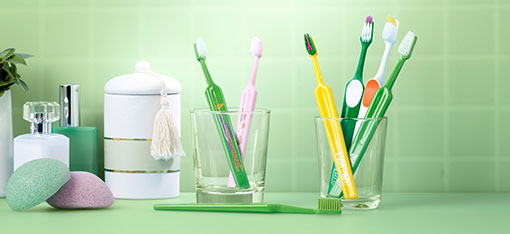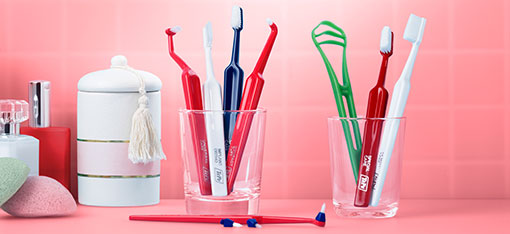Plastic Jargon

Many are making a concerted effort to consider their carbon footprint. Thinking about the products we use and how to dispose of them can become a bit confusing when trendy buzz words to describe that product are used interchangeably. TePe is consciously working to reach global climate goals and have introduced a new line of products to reduce CO2 emissions. Before we can understand how to decrease our CO2 emissions or carbon footprint, we need to wade through some of the plastic jargon that can often confuse us.
We see terms like recyclable, degradable, biodegradable, sustainable, and renewable used to describe products, but sometimes, these terms are used interchangeably. Let’s take a better look at what they mean.
Recyclable
The act of recycling is using materials that would become waste in a landfill and turning it into new products. The original product is destroyed to create or form a new product. Keeping in mind that just because we can throw a product into the recycling bin, it does not mean it can be recycled to create a new product. Often products made from multiple types of plastic cannot be recycled (e.g. toys and electronics). But products made from just one plastic material, like water bottles and blister packs made from PET, can be recycled.
Degradable
Bio-based and fossil-based plastics can break down or degrade; however, it does not mean it is gone. The plastics can degrade (not by way of microorganisms like bio-degradable and become smaller and smaller, so we no longer see it with our eyes, but they never go away; instead, they can stay in the soil or the ocean for hundreds of years. Though degradable plastics break down, so we have less litter, they do not degrade in a way that is kind to the environment, and those small particles still exist and can make their way into the food chain.
Bio-degradable
Durable plastics like PE, PET, and PP plastic are not bio-degradable. Bio-degradable plastic can be degraded/converted to carbon dioxide and water by microorganisms. Bio-degradable should not be confused with compostable. Compostable materials need a controlled environment for a specific timeframe. This means you cannot toss a bio-degradable or compostable product into the environment and think it will break down. The conditions need to be created for the living organisms to break the material down. Many products also have other materials in them that do not break down. Toothbrushes, for instance, usually have bristles that are anchored by a metal clip. The metal clip is not biodegradable, so you will need to remove the head of the brush and toss that into the appropriate waste container.
Sustainable
For materials such as plastic to be called sustainable, they must meet three requirements: be environmentally, economically, and socially sustainable. TePe has chosen to use a bio-based PE from sugar cane, which meets these three requirements.
Renewable
A renewable resource is a resource which can be used repeatedly and replaced naturally. Unlike non-renewable sources, like fossil-fuel or natural gas, renewables can be recreated with relatively short time intervals. TePe considers all elements of sustainability when sourcing raw materials, manufacturing, and transporting goods. The GOOD toothbrush is the first step in TePe’s sustainable product range, and they will work towards including more products in the future.
There are many benefits to the bio-based plastic that TePe has chosen to use. Bio-plastic is made from plants and plants absorb carbon dioxide from our atmosphere. When plants die, break down or burn, CO2 is released to the atmosphere. If everything is in balance, we have a neutral CO2 impact. The TePe GOOD products are made from the renewable resource and have a low carbon neutral footprint, making the life cycle of the product made from this material very small.
Bio-based PE is not biodegradable but will degrade; however, not to the levels that are safe for the environment. The toothbrush head has metal wires to secure the bristles, and if the head is removed, the handle can be tossed into recycling. If kept in tack, the entire toothbrush may go into household waste. If trash is burned where you live, the toothbrush will create CO2 that will then be reabsorbed by the next crop of sugar cane. In some countries, waste is burned to produce energy, and bio-based PE gives about four times the amount of energy at incinerations compared to bamboo.
TePe continues to take initiatives for long-term sustainable development. To learn more about the TePe GOOD initiative or the green energy they use to make the product line, visit tepeusa.com











Amazing article.
Leave a comment